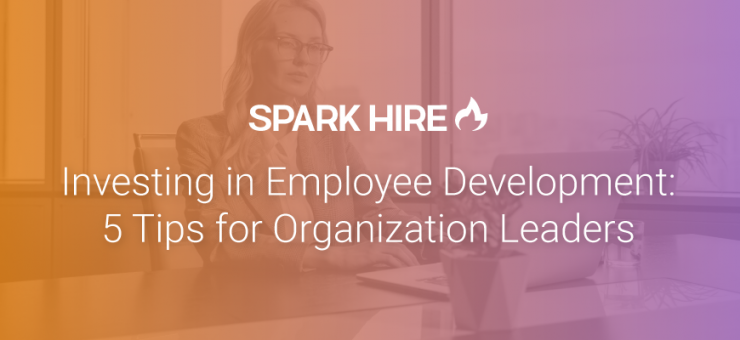As an HR leader, it’s your responsibility to promote and empower the professional development of your employees. Whether through management training, educational resources, or software training, it’s important to provide your employees with the necessary tools to succeed.
However, it’s no secret that 2020 has changed the landscape of the workforce, and this includes employee development programs. As working remotely has become the new normal, efficient and effective digital tools are more important than ever. While in the past, you could have walked to a neighboring desk to mentor a colleague or hosted an in-person training seminar, that is no longer the workplace reality.
One useful strategy to improve your professional development program during the era of remote work is to implement a learning management system. A learning management system, or LMS, helps provide engaging educational opportunities for your employees.
By implementing an LMS for your business, you enable employees to perform at their peak potential while also providing opportunities for further growth and development. However, there are a number of considerations to keep in mind when selecting and implementing an eLearning solution.
At Web Courseworks, we believe strongly in the power of eLearning to improve professional performance. With our experience and knowledge working with associations, we’ve compiled a list of best practices for implementing your own:
- Choose an engaging and intuitive LMS.
- Make sure integration tools are seamless.
- Build a flexible system.
- Track data analytics and reporting.
- Offer collaboration.
By creating customized learning experiences, tracking your users’ success, and making data-driven decisions, your LMS can drastically improve professional development efforts and day-to-day operations.
1. Choose an engaging and intuitive LMS.
In order for your employees to get the most out of the LMS you implement, you want to make the process enjoyable. As you conduct your search, look for a system that is easy to navigate, visually appealing, and highly interactive.
First and foremost, it should be simple for your employees to explore the system and locate an appropriate course. If the system is confusing or poorly organized, your employees may become frustrated before even getting started. The right LMS will have a logical informational hierarchy, a clear navigational menu, and a responsive layout that functions on a variety of screen sizes.
Next, tackle the system’s appearance. This is not a place where you should follow the saying, “Don’t judge a book by its cover.” Your employees will be more inclined to use a system that is visually appealing and well-designed. Ideally, you should find a that you can customize with your branding.
Lastly, when an LMS offers ample opportunities for interaction, members are more likely to engage with it longer and learn more. You’ll want to look for features including:
- Video tools for an engaging experience
- Learning games
- Interactive drag-and-drop elements
A visually appealing and interactive LMS will help ensure that your professional development program contrasts with the static, boring conference room training presentations of the past. With these features, you provide more entertainment and educational value for an overall positive learning experience.
2. Make sure integration tools are seamless.
Along with a presentation and navigation, integrations are critical for a successful LMS experience. The hope is for all of your digital course materials and training opportunities to live in one place, and an easily-integrated system makes this a possibility.
Prioritize an LMS that can integrate with any third-party systems you have in place. For example, you may want to connect with your:
- Webinar tool. Alongside the asynchronous content in your LMS, you may want to connect with your employees via live training webinars.
- Virtual event platform. An LMS can be an effective tool for conveying educational material from a virtual conference or other event that your business hosts.
Additionally, you’ll also want to confirm that the LMS can easily integrate with existing HR systems. Keeping track of continuing education data in a unified employee record will help you monitor growth and performance improvements over time. This can be especially beneficial for remote talent management since progress may otherwise be difficult to assess.
3. Build a flexible system.
With the ever-changing workplace environment, flexibility and adaptability within your LMS is more important than ever. You want to invest in an LMS system that can meet your business’s current needs now, but also can evolve alongside you.
Consider the following ways your needs may shift over the next few months or years:
- There are updates in industry trends and best practices.
- Your workplace setting shifts back to in-person.
- Your business implements new software systems.
- You adjust your standard onboarding and training procedures.
An LMS that offers streamlined course authoring and editing features will help you adapt to any of these shifts.
When you choose a system that gives you room to grow and add new courses as needed, you invest in a flexible solution that will meet your evolving business. However, you’ll want to be sure and check that the LMS you select doesn’t charge extra for these specific customizations.
In addition to adapting to the needs of your business overall, you’ll also want an LMS that adapts to the needs of each individual user. As your members interact with the LMS, they want their learning experience to be continually more personalized.
This personalization should exist within each course and across the entire system. Within a course, look for adaptive quizzes that dynamically change based on the employee’s answers. Then, if you’re offering multiple courses, the system should learn each employee’s interests and recommend more courses to expand their knowledge further.
4. Track data analytics and reporting.
At the end of the day, your LMS is only as effective as the data it can store and present. After you implement an LMS into your professional development program, you’ll want to have up to date information and analytics on its performance. After all, you’ve put a lot of time and effort into implementing the system, so you want to know whether it’s achieving its intended goals.
When selecting your LMS, keep an eye out for site-wide reporting features to understand the performance of your courses. Understanding which topics are most popular can help you select future courses employees will find interesting. This high-level data will indicate opportunities for expansion within your professional development program.
On a more granular level, you should also be able to analyze reports about the performance of individual learners within the course.
For example, metrics from comprehension quizzes and other embedded assessments help determine which sections may need clarification or additional context to enhance learning. According to Skyepack’s guide to curriculum development, this kind of data helps make iterative improvements to adapt to the changing needs of employees over time.
While all of this data can be helpful, it can feel overwhelming if you aren’t accustomed to it. To help minimize this challenge, some LMS providers may even provide services to help you draw actionable insights and achieve business results.
5. Offer collaboration.
In the era of social distancing and isolation, your employees are likely craving social interaction more than ever. Your LMS is a great opportunity to add a dose of human connection to the socially distanced workplace.
First, a collaborative community for learning often results in higher rates of productivity and motivation. Competition and discussion facilitates deeper engagement for employees.
In addition to the benefits for employees’ social well-being and motivation, collaboration is also helpful for learning outcomes. Studies show that social learning typically accounts for 75% of the knowledge people attain in the workplace. When users are encouraged to share their progress and freely ask questions, they often feel more empowered to expand their knowledge further.
To unlock these advantages, look for collaborative social learning tools including:
- Discussion forums
- Live chat
- Social media integration
- Peer-to-peer feedback
Social learning has been proven to have benefits in a variety of educational applications, from K-12 and college classrooms, to within an association LMS, or in a business setting like yours. Each of these options can help your business foster a spirit of community within your professional development courses.
A learning management system can offer powerful educational opportunities and training resources to your business’s employees. With a strong and full-featured LMS, your business will be well-equipped to foster employee growth and become more profitable.
However, to get the most out of your LMS, you must choose a system that can meet your needs now and in the future. Consider features like flexibility, reporting, collaboration, and interactivity as you investigate the options and decide on which system is best for your specific organization. Best of luck!
About the Author
 Amber Winter is the Director of Sales & Marketing at Web Courseworks. She’s committed to helping association executives realize the potential of their education programs and turn them into high performing revenue generators. Amber was named one of Madison, Wisconsin’s 40 under 40 and the number 1 LMS salesperson by Talented Learning.
Amber Winter is the Director of Sales & Marketing at Web Courseworks. She’s committed to helping association executives realize the potential of their education programs and turn them into high performing revenue generators. Amber was named one of Madison, Wisconsin’s 40 under 40 and the number 1 LMS salesperson by Talented Learning.











